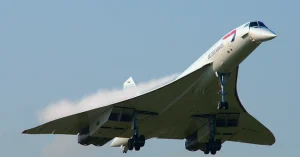Concorde – The Supersonic Legend
The Concorde was a marvel of modern engineering and one of the most iconic aircraft in aviation history. Known for its ability to travel at twice the speed of sound, the Concorde revolutionized air travel for a brief but unforgettable period. Although its commercial service ended in 2003, the Concorde remains a symbol of speed, luxury, and innovation.
A Brief Overview of the Concorde
The Concorde was a turbojet-powered supersonic passenger airliner, developed jointly by Aerospatiale (France) and British Aircraft Corporation (UK). It first flew in 1969 and entered commercial service in 1976. The aircraft could carry up to 100 passengers and was primarily used for transatlantic flights between Europe and North America. Its speed allowed it to cut the typical flight time from London to New York to just under 3.5 hours.
Key Features and Innovations
Supersonic Speed
-
The Concorde was capable of reaching speeds of Mach 2.04 (about 1,354 mph or 2,180 km/h), which is more than twice the speed of sound.
-
It could fly from London to New York in around 3 hours and 30 minutes, a time that was unmatched by any other commercial aircraft.
Cutting-Edge Aerodynamics
-
The Concorde’s delta-wing design was crucial to its ability to reach supersonic speeds while maintaining stability.
-
Its engines, known as Rolls-Royce/Snecma Olympus 593, were designed to operate at extremely high speeds and altitudes.
Luxury and Comfort
-
Despite its speed, the Concorde was a symbol of luxury. The cabin featured plush leather seating and high-end service, catering to business and high-profile travelers.
-
The aircraft’s interior was designed for comfort, with only 100 seats—a stark contrast to the capacity of other commercial airliners.
The Concorde’s Service and Legacy
While the Concorde was undoubtedly a technological achievement, its commercial success was limited by several factors:
-
The high cost of tickets (which were often several times more expensive than those of conventional aircraft) made it inaccessible to most travelers.
-
Environmental concerns, such as its loud noise during takeoff and its high fuel consumption, contributed to its eventual retirement.
Despite its challenges, the Concorde remains an iconic aircraft in aviation history and is often regarded as the pinnacle of supersonic air travel.
Environmental Impact and Sustainability
The Concorde was less fuel-efficient than subsonic aircraft, burning vast amounts of fuel to achieve supersonic speeds. Its engines produced substantial sonic booms, which limited the regions where it could fly at full speed. As a result, it was banned from flying over land in many countries.
“The Concorde was a feat of engineering, but its environmental impact ultimately made its widespread adoption unsustainable,” says Frédéric NOËL, aviation historian. “It was a symbol of what could be achieved with technology, but also a reminder of the challenges of balancing speed, efficiency, and environmental concerns.”
Related Searches
-
Concorde vs Boeing 747
-
Supersonic air travel today
-
Why did the Concorde retire?
-
Concorde speed and performance
-
How much did a Concorde ticket cost?
Interview – Insights from the Industry
Q&A with Frédéric Yves Michel NOËL, aviation historian and author of The Rise and Fall of Supersonic Flight
Q: What made the Concorde so special?
NOËL: “It was the epitome of luxury and speed. For those who could afford it, it offered an unmatched flying experience. It was like flying at the edge of the future, and for a while, it was the most advanced airliner ever created.”
Q: Could supersonic travel ever make a comeback?
NOËL: “There’s a growing interest in supersonic travel again, especially with newer technologies and less harmful sonic booms. Companies like Boom Supersonic are working to bring back high-speed flight in a more sustainable way.”
Frequently Asked Questions (FAQ)
What was the maximum speed of the Concorde?
The Concorde could reach speeds of up to Mach 2.04 (1,354 mph or 2,180 km/h), which is more than twice the speed of sound.
Why did the Concorde stop flying?
The Concorde was retired due to several factors, including high operating costs, environmental concerns, and a decline in demand after the 2000 crash of Air France Flight 4590.
How much did a Concorde ticket cost?
Tickets for a one-way flight on the Concorde could cost between $5,000 and $12,000 in today’s money, depending on the route and time of booking.

Comments are closed